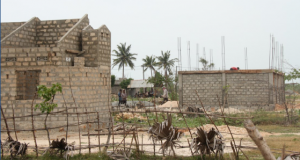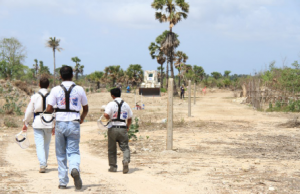4th April 2015 Colombo, Sri Lanka
Treading carefully

To mark Mine Awareness and Action Day, I asked our partners HALO Trust to write about their work in Sri Lanka.
“The HALO Trust is the world’s largest and oldest humanitarian demining organisation, with staff in 17 counties and territories around the world. Our core activity is clearing mine-contaminated land needed for housing, agriculture and infrastructure, allowing people to rebuild their homes and lives after the trauma of war.

In 2002 we began operations in Jaffna and after the end of the war in 2009 we expanded into the former LTTE-held areas around Kilinochchi. With a workforce in northern Sri Lanka that has often numbered over 1,000 local staff, we have cleared more than 1,000 hectares of contaminated land. Over 20% of this has been achieved with support from the UK government. In thirteen years over 190,000 anti-personnel mines have been removed to enable the resettlement of 200,000 people.
The residents of the small fishing village of Akkarai in Iddaikkadu GN on the northern side of the Jaffna peninsula are some of the thousands of beneficiaries of UK-funded mineclearance in the Northern Province. Their stories of hardship and uncertainty that impacted their almost 30-year displacement are typical. Following clearance, former residents and new generations of families are now returning to their land to rebuild and start anew.
In 1986 the Sri Lankan Army (SLA) advanced from Palaly and set up a camp in Akkarai to defend against LTTE attacks from the east, forcing villagers to abandon their homes, boats and livelihoods. In 1990 the 105 families were allowed to return to the area, but when one man lost his leg in a mine accident, people were once again displaced and the surrounding land was occupied by the SLA. This land then became part of the High Security Zone, which covered large tracts of residential land on the northern coast of the peninsula.

In early 2012, mines were found while a road was being cleared through overgrown vegetation that had consumed the village. We were asked to clear the area and we removed over 100 mines from just over two hectares. The land was immediately in demand but, due to the substantial passage of time, the number of families with connections to Akkarai who wanted to settle there now numbered 300. After only six months over 90 of those families had returned and built temporary shelters and the old minefield was unrecognisable.
Resettlement at Akkarai is still in its early days and there are many challenges to rebuilding the community, particularly water shortages and the crippled fishing facilities. Nevertheless, among those who have not yet resettled there is a strong desire to return and high demand for the land. Now resettlement has begun, there is a sense of optimism among returnees.

After almost 30 years of displacement and uncertainty they are keen to reclaim their village and improve their standard of living. Mineclearance has acted as a catalyst for the provision of aid and development support. Swiss Agency for Development and Cooperation (SDC) has built 35 permanent houses in Akkarai, each with a well and toilet. The local government provided toilets for a further 11 families.
Our deminers continue to clear minefields across northern Sri Lanka to enable the long-awaited resettlement of protracted IDPs. In the coming year alone, over 43,000 people in northern Sri Lanka will benefit from our work.”
